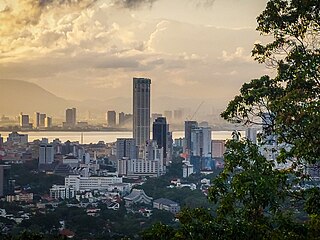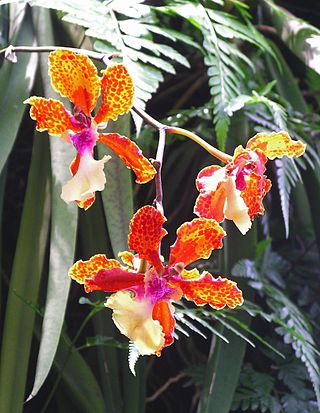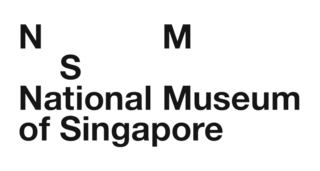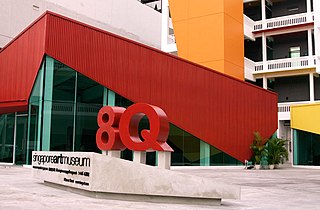
George Town is the capital of the Malaysian state of Penang, and the eighth-most populous city proper in Malaysia. The historical core of the city, covering an area of 19 km2 (7 sq mi), has a population of 158,336 in the 2020 census, making it among the densest urban areas in Asia; while the city proper has an estimated population of 794,313 inhabitants, presiding over an area of 306 km2 (118 sq mi). George Town is also the core city of the Greater Penang Conurbation, the second largest metropolitan area in Malaysia with 2.82 million inhabitants.

The Peranakans are an ethnic group defined by their genealogical descent from the first waves of Southern Chinese settlers to maritime Southeast Asia, known as Nanyang, namely the British Colonial ruled ports in the Malay Peninsula and the Indonesian Archipelago, as well as Singapore. Peranakan culture, especially in the dominant Peranakan centres of Malacca, Singapore, Penang, Phuket and Tangerang, is characterized by its unique hybridization of ancient Chinese culture with the local cultures of the Nusantara region, the result of a centuries-long history of transculturation and interracial marriage.

Tourism in Singapore is a major industry and contributor to the Singaporean economy.

The Singapore Botanic Gardens is a 164-year-old tropical garden located at the fringe of the Orchard Road shopping district in Singapore. It is one of three gardens, and the only tropical garden, to be honoured as a UNESCO World Heritage Site. The Botanic Gardens has been ranked Asia's top park attraction since 2013, by TripAdvisor Travellers' Choice Awards. It was declared the inaugural Garden of the Year by the International Garden Tourism Awards in 2012.

The Government of Singapore is defined by the Constitution of the Republic of Singapore to comprise of the President and the Executive. Executive authority of Singapore is vested in the President but exercised on the advice of the Cabinet led by the Prime Minister. The President, acting as the Head of State, may only act in their discretion in appointing the Prime Minister, acting as the Head of Government; as well as withholding consent for the dissolution of Parliament; along with performing key checks on the Government in addition to the ceremonial duties of the Head of State inherited from the Westminster system. The Cabinet, consisting of the Prime Minister and ministers appointed by the President on the Prime Minister's advice, is responsible for heading the Executive through ministries and other statutory boards. At the end of the term or at any time during the term, once the President has consented to a request made by the Prime Minister to dissolve Parliament, Parliamentary General Elections are held to elect members of Parliament for a new term. The President, in their discretion, then appoints a Prime Minister who is a member of Parliament representing any political party or coalition of political parties who in their judgement is likely to command the confidence of the majority of the members of Parliament. The Prime Minister then forms the Government and, along with the Cabinet, sets the general direction and control of the Government for the next term.

The Asian Civilisations Museum (ACM) is an institution which forms a part of the four museums in Singapore, the other three being the Peranakan Museum, the National Museum of Singapore and the Singapore Art Museum.

Bras Basah MRT station is an underground Mass Rapid Transit (MRT) station on the Circle line (CCL) located in the Museum planning area, Singapore. It is underneath Bras Basah Road, bordering Waterloo Street and Queen Street. Located next to the Singapore Management University (SMU), this station is in proximity to the National Museum of Singapore, the Singapore Art Museum, Peranakan Museum and the Singapore School of the Arts. The station is connected to the nearby Bencoolen station on the Downtown line (DTL) via an unpaid link.

The Singapore Art Museum is an art museum is located in the Downtown Core district of Singapore. It is the first fully dedicated contemporary visual arts museum in Singapore with one of the world’s most important public collections by local, Southeast and East Asian artists. It collaborates with international art museums to co-curate contemporary art exhibitions.

The Old Tao Nan School is a historic building in Singapore, located along Armenian Street in the Museum Planning Area, within the Central Area. The building was originally built for the Tao Nan School to serve the local Hokkien community, but the school has since been relocated to its current location in Marine Parade. The building was then used as a wing of the Asian Civilisations Museum, and now houses the Peranakan Museum. It was gazetted as a national monument on 27 February 1998.

The National Museum of Singapore is a public museum dedicated to Singaporean art, culture and history. Located within the country's Civic District at the Downtown Core area, it is the oldest museum in the country. It is one of the largest museums in Asia.

Joo Chiat Road is a road in Katong and a residential conservation area located in the east coast of Singapore. It has won several architectural and heritage awards including the United Nations' UNESCO Asia-Pacific Awards for Cultural Heritage Conservation at 125 Joo Chiat Road. It has overtaken Holland Village in terms of most diverse eateries. Currently, Joo Chiat has become one of the hippiest and coolest towns in Singapore, with both rich and young professionals flocking to its numerous Michelin awarded restaurants. Joo Chiat Road carries a rich historical Peranakan architecture and is infused with rich Peranakan culture, as it has the most historical Peranakan buildings in the Katong district. Joo Chiat was named after a businessman by the name of Chew Joo Chiat after he donated the land to the Municipality of Singapore.

The Museum Planning Area is a planning area located in the Central Area of the Central Region of Singapore. The area plays a "bridging role" between the Orchard area and the Downtown Core, which necessitates proper transport networks for vehicles, pedestrians and public transport. Due to the sheer size of green areas in the district, the Urban Redevelopment Authority (URA) has designated it a 'green lung' in the Central Area. However, the Museum Planning Area is also home to cultural and commercial activities. Around 65% of the area is available for future development, making it a hotbed for new infrastructure and buildings.

Gan Eng Seng was a Chinese businessman and philanthropist who was one of the early pioneers of Singapore. He is known for his generosity to many charitable causes in Malaya and Singapore during the British colonial era. Some of his most recognised contributions were the setting up of Gan Eng Seng School, the Thong Chai Medical Institution, Tan Tock Seng Hospital, and the Ee Hoe Hean Club.

The culture of Singapore has changed greatly over the millennia. Its contemporary modern culture consists of a combination of Asian and European cultures, mainly by Malay, South Asian, East Asian and Eurasian influences. Singapore has been dubbed as a country where "East meets West", "Gateway to Asia" and a "Garden city".

The Islamic Arts Museum Malaysia is a museum in Kuala Lumpur, Malaysia. It was officially opened on 12 December 1998. The museum is the largest museum of Islamic arts in South East Asia with more than seven thousands artifacts from the Islamic world.

SAM at 8Q is the annexe of Singapore Art Museum - Singapore's contemporary art museum. Located at the heart of the city, it derives its name from the museum's location at No. 8 Queen Street near Bras Basah Road. SAM at 8Q is also approximately 88 steps away from Singapore Art Museum.

The Peranakan Museum is a museum and gallery in the Museum district of Singapore that specialises in the country's Peranakan culture. It is the sister museum of the Asian Civilisations Museum.

Baba House is a museum in Singapore, showcasing Peranakan history, architecture and heritage. It is a traditional Peranakan pre-war terrace-house which was formerly owned by the family of a 19th-century shipping tycoon Wee Bin who settled in Singapore, after arriving from the southern Chinese province of Fujian. The Baba House is also an outpost of the National University of Singapore (NUS) Museum and co-managed by the NUS Centre for the Arts.
Koh Seow Chuan is a founder of DP Architects, a philatelist, and philanthropist.


















